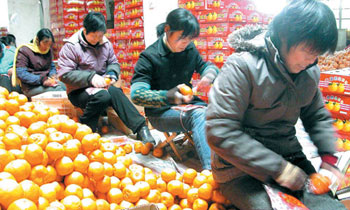The curative effect of the new product of wheat "cancer" is not clear.
Original title: it is urgent to develop new drugs for wheat scab.

With the temperature rising day by day, wheat in various provinces and regions of our country have entered the heading and flowering stage one after another. This period is not only the key period of wheat grain formation, but also the most critical time to control wheat scab. Recently, the National Agricultural Technology extension Service Center released a forecast on the occurrence trend of wheat scab in 2016. in the report, the occurrence of wheat scab in China in 2016 is predicted by using the key words "high carrying rate in the field", "poor resistance of varieties" and "heavy rainfall".
Wheat scab is one of the most serious diseases of wheat at spike stage. The disease is common all over the world, and it has been one of the most serious diseases in the south of Huaihe River and the middle and lower reaches of the Yangtze River in China. The terrible thing of wheat scab is not only that it can cause serious reduction of wheat yield or even no harvest, but more importantly, after it harms wheat, it can produce a variety of mycotoxins, especially deoxynivalenol (DON), which affect human and animal health, worsen grain quality and reduce seed value. China stipulates that the diseased grains of wheat scab shall not exceed 4%, and the content of DON in wheat grains exceeding 1mg/kg can not be eaten.
At present, in the prevention and control of wheat scab, China actively adopts the comprehensive control strategy based on agricultural control, combined with disease-resistant varieties and chemical protection in the critical period. In recent years, with the change of domestic farming system, continuous cropping of rice and wheat, continuous cropping of jade and wheat, and the gradual expansion of no-tillage, blank field and straw returning area, all these provide favorable conditions for the survival and accumulation of bacterial sources in the field. it also makes the occurrence probability of wheat scab increase year by year. At present, the most economical, effective and fundamental measure to control wheat scab is to select disease-resistant varieties. In recent decades, domestic breeders have done a lot of work in breeding and popularizing disease-resistant varieties, and a number of disease-resistant varieties such as Yangmai, Ningmai and Zhenmai have been selected, but generally speaking, their disease resistance and high yield are not ideal.
Although wheat scab is known as the "cancer" of wheat, it is preventable and untreatable. However, under the condition that the disease resistance of varieties is generally poor, chemical control is still the key to reduce the occurrence of scab. It is understood that at present, China has registered a total of 211 preparation products for the prevention and control of wheat scab, involving 21 kinds of active ingredients, of which carbendazim, thiophanate-methyl, triadimefon and thiram are the most single and compound preparations, accounting for 86.26% of the total registered.
The products are still concentrated in benzimidazoles and triazoles, especially carbendazim. As the most important and commonly used chemical agent for the control of wheat scab in China, carbendazim plays a very important role in the control of wheat scab. However, since the 1970s, carbendazim has been used in the control of wheat scab for more than 40 years. Single or repeated use of carbendazim for a long time has led to drug resistance of Fusarium graminearum. The reality of resistance has made the already scarce wheat scab control agents even more stretched.
Therefore, it is urgent to seek and develop new agents to control wheat scab. At present, the most popular and common choice in the market is the mixture of tebuconazole and prochloraz and the related mixture of cyanostrobin. Compared with the pesticides used to control other diseases, the pesticides specially used to control wheat scab are still insufficient.
Do multinational companies have good products? Among the 211 pesticide products registered in China, only Andormai multinational company registered the mixture of prochloraz and tebuconazole, while Top6, led by Syngenta, was collectively invisible and did not register any variety specifically for the control of wheat scab.
It is worth noting that among the 282 products that are in the field trial stage, we have found multinational corporations, mainly Bayer's 430g/L tebuconazole suspension and 18.2% tebuconazole + 9.1% oxime myxim suspension, BASF 12.5% pyrazole carbendazim + 4.7% fluconazole suspension, and Syngenta 200g / L fluazolyl hydroxylamine suspension.
Therefore, on the whole, the pesticides for the control of wheat scab began to increase gradually, but the varieties were relatively few, and the effect still needed to be tested. Pesticide enterprises should speed up the development of new agents for the control of wheat scab in order to meet the actual production needs. (Zheng Min)
Related
- A course of planting techniques and methods on how to grow carrots
- How to plant the latest tulips?
- Is it better to pick tea in the morning or in the afternoon? When is the best time for tea to be picked? what is the third or fifth tea?
- Launch Yuanxiao Happy combination Haocha + Tea Yuan healthy Taste
- Penghu Tourism "Fireworks 20 Parade with You"
- 2022 West Lake Happiness holds "Digital Revitalization Voucher" and draws iphone13 and laptop.
- Banqiao Fuzhou social houses are designed to change start-up combined with police elimination to create a safe and livable environment
- The convenient measure of "mechanical weeding" in Xinbei has been abused and the Agriculture Bureau has imposed heavy penalties on the illegal land consolidation.
- Changgeng University Joins Hands with Four Memory Factories to Rescue Memory Talent Shortage
- The list of Taiwan's top 100 MVP managers is listed by the Director-General of the Farmers' Association of Sanxia District.



